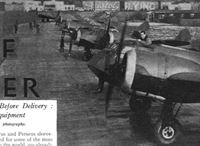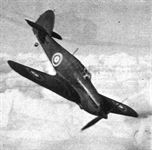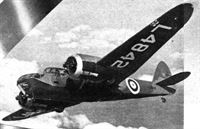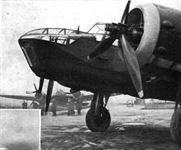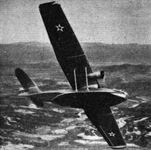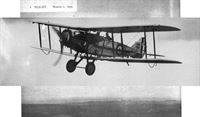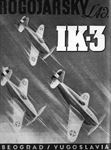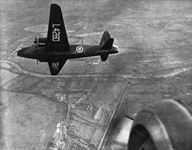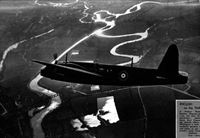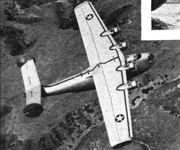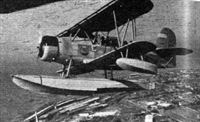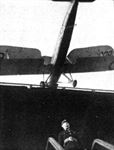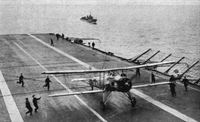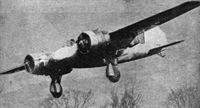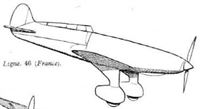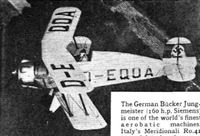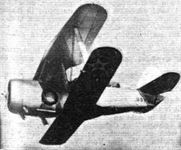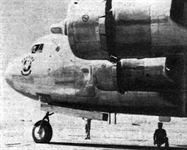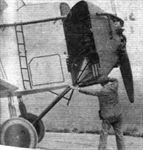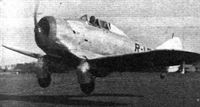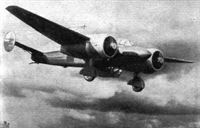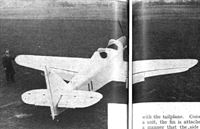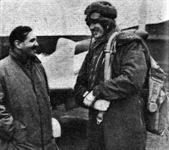Фотографии
-
I.15 (Russia)
Самолёты на фотографии: Поликарпов И-15 - Россия - 1933
-
Standard Russian bomber.
Самолёты на фотографии: Архангельский, Туполев СБ / АНТ-40 - Россия - 1934
-
Douglas B.19 (America)
Самолёты на фотографии: Douglas A-20 Boston / Havoc / P-70 Nighthawk - США - 1938
-
Arado 80 (Germany)
Самолёты на фотографии: Arado Ar.80 - Германия - 1935
-
Самолёты на фотографии: Armstrong Whitworth Whitley / A.W.38 - Великобритания - 1936
-
The Mark IV and V Armstrong Whitworth Whitleys are having Rolls-Royce Merlin engines. With the two-speed supercharged units the top speed should be over 250 m.p.h.
Самолёты на фотографии: Armstrong Whitworth Whitley / A.W.38 - Великобритания - 1936
-
Performance figures for the Messerschmitt Me 109 (DB 600) have not yet been released.
Самолёты на фотографии: Messerschmitt Bf.109 / Bf.109B / Bf.109C / Bf.109D - Германия - 1935
-
Регистрационный номер: K7033 The first Bristol Blenheim bomber which set a new standard for performance in its category.
Самолёты на фотографии: Bristol Blenheim - Великобритания - 1936
-
The Blenheim high-speed bombers fitted with 840 h.p. Bristol Mercury VIII engines awaiting delivery from the company's Filton aerodrome
Самолёты на фотографии: Bristol Blenheim - Великобритания - 1936
-
A typical R.A.F. Blenheim showing the retractable turret in the extended position.
Самолёты на фотографии: Bristol Blenheim - Великобритания - 1936
-
The operational tell-tale panel on the Curtiss Wright 20 as it appears in experimental form. It is placed immediately below the Sperry panel and, consequently, in full view of both the first and second pilots.
Самолёты на фотографии: Curtiss-Wright C-46 / CW-20 Commando - США - 1940
-
The Dewoitine D.520 which is said to lend itself well to rapid quantity production.
Самолёты на фотографии: Dewoitine D.520 - Франция - 1938
-
THE GOLDEN GATE: A distinctly striking picture of one of United Airways Douglas D.C. is flying over San Francisco Bay and the Treasure Island Exposition ground, which will be seen behind the fuselage of the machine. The Exposition has actually been laid out on an artificial island and this will afterwards be a civil landplane and flying boat base. P.A.A. are already operating therefrom.
Самолёты на фотографии: Douglas DC-3 / C-47 Skytrain/С-53 Skytrooper / Dakota - США - 1935
-
Регистрационный номер: D-AYWI The Dornier Do.24, as supplied to the Governments of Germany and the Netherlands;
Самолёты на фотографии: Dornier Do.24 - Германия - 1937
-
Focke-Wulf FW 159 (Germany)
Самолёты на фотографии: Focke-Wulf FW.159 - Германия - 1935
-
The installation of a 23mm. Madsen shell-gun on a Curtiss Hawk 75. The upper sketch shows how the rear part of the weapon is faired.
Самолёты на фотографии: Curtiss Hawk 75 / P-36 / Mohawk - США - 1935
-
SEEING FOR HIMSELF: Mr. W. J. Sanderson, president of Fleet Aircraft of Canada, Ltd., Fort Eerie, Ontario, is an accomplished pilot, and he recently visited the Handley Page aerodrome at Radlett and flew a Hampden. His company, which is one of the manufacturing units of Canadian Associated Aircraft, Ltd., is to build Hampdens.
Самолёты на фотографии: Handley Page Hampden / H.P.52 - Великобритания - 1936
-
Самолёты на фотографии: Handley Page Hampden / H.P.52 - Великобритания - 1936
-
Hampdens being delivered in quantity with two-speed supercharged Bristol Pegasus radials. H.P. lift slots make for brilliant performance in the Hampden and Hereford.
Самолёты на фотографии: Handley Page Hampden / H.P.52 - Великобритания - 1936
-
Henschel Hs 126 observation monoplanes of the Luftwaffe. This is one of the types released by the German Government for export.
Самолёты на фотографии: Henschel Hs 126 - Германия - 1936
-
Регистрационный номер: L1548 Armed, for the time being at least, with eight machine guns, the 335-m.p.h. Hawker Hurricane can alternatively be fitted with shell-firing armament.
Test pilot Philip Lucas diving Hurricane Mk I L1548 in September 1938.Самолёты на фотографии: Hawker Hurricane - Великобритания - 1935
-
The pilots who broke a speed-with-load record with a Junkers bomber with Jumo 211's having the gilled nose radiators illustrated.
Самолёты на фотографии: Junkers Ju.88 - Германия - 1936
-
Самолёты на фотографии: Supermarine Spitfire - Великобритания - 1936
-
The Supermarine Spitfire is believed to be the fastest fighter in large-scale production in the world. It does 362 m.p.h. with a Rolls-Royce Merlin II.
Самолёты на фотографии: Supermarine Spitfire - Великобритания - 1936
-
The North American Harvard as used by the R.A.F.
Самолёты на фотографии: North American T-6 Texan / AT-6 Harvard - США - 1935
-
A standard type of Japanese bomber
Самолёты на фотографии: Mitsubishi Ki.21 - Япония - 1936
-
Henschel Hs 123 (Germany)
Самолёты на фотографии: Henschel Hs 123 - Германия - 1935
-
The Ju.87 dive-bomber is one of the new German Service machines using the Junkers Jumo 211 inverted vee-twelve liquid-cooled engine.
Самолёты на фотографии: Junkers Ju.87 - Германия - 1935
-
DIVE BOMBERS OF THE LUFTWAFFE: Junkers Ju.87 two-seater dive bombers (Jumo 211 engine) of the German Air Force. These machines have a special flap for reducing the diving speed and permitting a close approach to the target. Bomb displacement gear - for guiding the bomb clear of the airscrew - is visible behind the radiator housing.
Самолёты на фотографии: Junkers Ju.87B - Германия - 1938
-
A standard dive bomber of the German Air Force is the Junkers Ju. 87 with Jumo 211 engine. Under the wing are flaps to reduce the diving speed.
Самолёты на фотографии: Junkers Ju.87B - Германия - 1938
-
ROYAL VISIT: Their Majesties the King and Queen began their visit to Birmingham last week by inspecting the Austin shadow factory at Longbridge. Accompanied by Mr. Neville Chamberlain and Lord Austin, they saw Fairey Battles in production.
Самолёты на фотографии: Fairey Battle - Великобритания - 1936
-
A fine example of the single-engined bomber: The Fairey Battle with Rolls-Royce Merlin II engine. Hundreds are in service.
Самолёты на фотографии: Fairey Battle - Великобритания - 1936
-
A well-established type in service with the Italian Air Force is the Fiat BR20, a commodious machine with two Fiat radials giving 1,000 h.p. each at altitude.
Самолёты на фотографии: FIAT BR.20 Cicogna - Италия - 1936
-
An adaptation of the Lockheed 12 has been produced for advanced twin-engine training.
Самолёты на фотографии: Lockheed Electra Junior 12 - США - 1936
-
Регистрационный номер: L4842 [2] F/O. A. J. Pegg, Bristol test pitot, takes one of the new "long-nosed" Blenheims past the vertical in parting company with another Bristol machine bearing "Flight's" chief photographer. Generally classed as a bomber, the Blenheim is potentially a very formidable fighter or long-range strategical reconnaissance machine with a nominal top speed of 295 m.p.h. and a range slightly under 2,000 miles. This picture was secured at 7,000 ft. where the two fully supercharged 840 h.p. Mercury VIIls were beginning to feel at home.
Самолёты на фотографии: Bristol Blenheim IV/Bolingbroke - Великобритания - 1937
-
Регистрационный номер: L4842 [2] Outstanding among the world’s highspeed bombers is the latest version of the Bristol Blenheim which does 295 m.p.h. and has a range of 1,900 miles.
Самолёты на фотографии: Bristol Blenheim IV/Bolingbroke - Великобритания - 1937
-
The “long-nosed ” version of the Bristol Blenheim has much to recommend it as a long-distance strategical reconnaissance type.
Самолёты на фотографии: Bristol Blenheim IV/Bolingbroke - Великобритания - 1937
-
One of the best Continental bombers in production to-day is the Polish P.Z.L. Los with two Bristol Pegasus engines. The low aspect ratio of the wing is a notable feature.
Самолёты на фотографии: PZL P.37 Los - Польша - 1936
-
Английский аэроплан "Бристоль", состоявший на вооружении болгарской армии в 1913 году.
The Bristol-Prier school monoplane. In the pilot’s cockpit is Mr. (now Group Capt.) Harry Busteed.Самолёты на фотографии: Bristol Prier monoplane / P-1 - Великобритания - 1911
-
Регистрационный номер: K8310 The Boulton Paul Defiant two-seater multi-gun turret fighter which has been adopted as a standard type by the R.A.F. The engine is a Rolls-Royce Merlin.
Самолёты на фотографии: Boulton Paul Defiant / P.82 - Великобритания - 1937
-
The Consolidated model 28, generally similar to the PBY series of the American Navy.
Самолёты на фотографии: Consolidated PBY Catalina - США - 1935
-
Westland Lysanders in service with the R.A.F. (with Mercury or Perseus engine) awaiting delivery to a unit. The Lysander was designed from the beginning as a specialised Army co-operation machine.
Самолёты на фотографии: Westland Lysander - Великобритания - 1936
-
A close-up of one of the sleek He.111s now in service in large numbers with the German Air Force. This machine must be one of the most formidable of its class in the world.
The Heinkel He 111K with two Daimler Benz DB 600 engines is believed to equip a large proportion of Germany’s bombing force.Самолёты на фотографии: Heinkel He-111 - Германия - 1935
-
I.16 (Russia)
Самолёты на фотографии: Поликарпов И-16 тип 5 (6) - Россия - 1934
-
Регистрационный номер: L8341, L8342, L8343 Miles Magisters before delivery from their manufacturer's Reading Aerodrome.
Самолёты на фотографии: Miles Magister / M.14 - Великобритания - 1937
-
Регистрационный номер: D-IRUU The German Arado Ar. 96.
Самолёты на фотографии: Arado Ar.96 - Германия - 1938
-
Регистрационный номер: C4740 A Bristol F.2b Mk IV C4740 of the Cambridge University Air Squadron.
The aeroplane which made the name "Bristol" famous. The Bristol Fighter, F.2.B., which acquired the affectionate title “Brisfit” during the war. The engine was a Rolls-Royce Falcon of 275 h.p.Самолёты на фотографии: Bristol F.2A/F.2B Fighter - Великобритания - 1916
-
The Bristol “family” of 1920. From left to right the types are the Tourer, the Scout type F, the Babe, the monoplane, and the “Brisfit.” Behind them all is the huge Pullman passenger-carrier.
Самолёты на фотографии: Bristol Babe - Великобритания - 1919Bristol Braemar / Pullman - Великобритания - 1918Bristol F.2A/F.2B Fighter - Великобритания - 1916Bristol M.1A / M.1B / M.1C - Великобритания - 1916Bristol Scout E / F - Великобритания - 1918Bristol Tourer - Великобритания - 1919
-
FLOAT RETRACTION is a feature of new military flying boat - the Glenn Martin patrol bomber. The American machine, which has a span of 118ft., is believed to have two of the new Wright two-row Cyclones of something like 1,500 h.p. each.
Самолёты на фотографии: Martin PBM Mariner / Type 162 - США - 1939
-
The first Bristol aeroplane - the “Box Kite,” with 50 h.p. Gnome rotary engine, constructed by the British and Colonial Aeroplane Co., which eventually became the present Bristol Aeroplane and Motor Co. They were very similar to the Henry Farman, and large numbers were built and used for training purposes.
Самолёты на фотографии: Bristol Boxkite - Великобритания - 1910
-
Early aviation in India; a Bristol “Box Kite” was demonstrated in 1911 by Henri Jullerot.
Самолёты на фотографии: Bristol Boxkite - Великобритания - 1910
-
Early streamlining: a “Box Kite” with a cowling over the pilot’s legs.
Самолёты на фотографии: Bristol Boxkite - Великобритания - 1910
-
The torpedo on a German Arado Ar. 95, a particularly versatile biplane, with B.M.W. radial engine.
Самолёты на фотографии: Arado Ar.95 - Германия - 1936
-
Ikarus Orkan (Yugoslavia)
Самолёты на фотографии: Ikarus Orkan - Югославия - 1940
-
Curtiss XP-40 (America)
Самолёты на фотографии: Curtiss P-40 Tomahawk - США - 1939
-
A popular attack type on the export market, the Vultee V-12 can alternatively carry a heavy load of “demolition” bombs. It is here seen with a 1,100-lb. projectile in a faired rack.
Самолёты на фотографии: Vultee V-12 - США - 1939
-
Avia 35 (Czechoslovakia).
Самолёты на фотографии: Avia B-35 / Av.135 - Чехословакия - 1938
-
Регистрационный номер: G-EAVP PROM THE AERIAL DERBY: L. L. Carter crosses the finishing line as first man home and winner of the Derby Handicap.
A Bristol monoplane with Lucifer engine was a low-power version of the military monoplane.Самолёты на фотографии: Bristol M.1A / M.1B / M.1C - Великобритания - 1916
-
The De Havilland Don (D.H. Gipsyking engine) as employed for communication work and for certain types ol training in the R.A.F.
Самолёты на фотографии: De Havilland Don / D.H.93 - Великобритания - 1937
-
Регистрационный номер: L3243 Although employed by the R.A.F. on target-towing duties, the Hawker Henley is one of the world’s finest single-engined bombers.
Самолёты на фотографии: Hawker Henley - Великобритания - 1937
-
Adopted as a standard type by the French Air Force, the Amiot 340 is one of the best looking of modern twin-engined bombers. It has two Gnome Rhone N 14 engines.
Самолёты на фотографии: Amiot Amiot 340/350 - Франция - 1937
-
A nose view of the German Dornier Do.17 showing the installation of its Daimler Benz DB 600 engines, which confer a very good performance.
Самолёты на фотографии: Dornier Do.17 - Германия - 1934
-
Armourers installing the R.A.F. model of the Browning gun on a Gloster Gladiator
Самолёты на фотографии: Gloster Gladiator - Великобритания - 1934
-
The sketch shows the disposition, in relation to the pilot's cockpit, of the nose armament of one version of the Fokker G.I. The large guns are 23 mm. shell-firing Madsens and the smaller ones rifle-bore Madsens
Самолёты на фотографии: Fokker G.I Le Faucheur - Нидерланды - 1937
-
In small-scale production for the French Air Force, the Bloch 151 is normally fitted with a Gnome Rhone 14N0, though a Twin Wasp is being tried experimentally. With a Gnome Rhone 14N the Bloch 151 does well over 300 m.p.h.
Самолёты на фотографии: Bloch MB.150/151/152/155C1 - Франция - 1937
-
A fine example of the light fighter - the 450 h.p. Renault-engined Caudron Cyclone.
Самолёты на фотографии: Caudron C.710 Cyclone - Франция - 1936
-
Самолёты на фотографии: Ikarus IK-3 - Югославия - 1938
-
Регистрационный номер: L4280 GEODETICS ON THE GRAND SCALE: Flt. Lt. J. Summers, chief test pilot to the Vickers-Armstrong group, shows off some of the finer points of the Wellington long-range bomber near Weybridge. Wellingtons are coming through at a highly creditable rate and are taking up the brightly burning torch of geodesy from the Wellesley. The engines are Bristol Pegasus.
Самолёты на фотографии: Vickers Wellington / Type 271 - Великобритания - 1936
-
ENGLISH as the THAMES. A Vickers Wellington bomber - Pegasus-powered - on test near its home aerodrome; those who know their Thames will see exactly where. The Wellington is built on the exclusive geodetic system and ranks as one of the world’s most formidable bombers.
Самолёты на фотографии: Vickers Wellington / Type 271 - Великобритания - 1936
-
A Junkers Jumo 205 Diesel in a Ju.86K.
Самолёты на фотографии: Junkers Ju.86 - Германия - 1934
-
Регистрационный номер: D-ALOH Junkers Ju.86K (Germany)
Самолёты на фотографии: Junkers Ju.86 - Германия - 1934
-
Breda 88 (Italy)
Самолёты на фотографии: Breda Ba.88 Lince - Италия - 1936
-
Bombs about to be loaded into an American Douglas B-18 bomber. It will be seen that the bomb doors are already open to recede the projectiles.
Самолёты на фотографии: Douglas B-18 Bolo - США - 1935
-
Bloch 174 (France)
Самолёты на фотографии: Bloch MB.174/175/176 - Франция - 1938
-
The Breguet 690 which has been adopted by France as a standard attack type. It is said to do more than 290 m.p.h. and to have a range of over 1,000 miles.
Самолёты на фотографии: Breguet Br.690 - Франция - 1938
-
Loire-Nieuport 40 single-seater dive-bomber (France)
Самолёты на фотографии: Loire-Nieuport LN 401/411 - Франция - 1938
-
Japanese light bomber
Самолёты на фотографии: Kawasaki Ki.32 - Япония - 1937
-
Breda 65 (Italy)
Самолёты на фотографии: Breda Ba.65 - Италия - 1935
-
Italy’s Meridionali Ro.37-bis is a reconnaissance type usually fitted with a Piaggio engine. There are sliding observation windows in the sides of the fuselage.
Самолёты на фотографии: IMAM(Meridionali) Ro.37/37bis - Италия - 1933
-
The Douglas O-46-A (Pratt & Whitney Twin Wasp Junior)
Самолёты на фотографии: Douglas O-46 - США - 1934
-
The North American O-47 Three-seat Observation Monoplane (Wright "Cyclone" engine).
America's present standard observation (army co-operation) type is the Cyclone-engined North American O-47. There are windows in the bottom of the fuselage.Самолёты на фотографии: North American O-47 - США - 1935
-
Spraying a thin solution of whitewash to simulate a gas attack, Douglas (Northrop) machines of the U.S. Army Air Corps demonstrate one of the functions of an attack squadron.
Самолёты на фотографии: Northrop A-17 / 8A Nomad - США - 1934
-
So low do attack machines fly that they must drop their fragmentation bombs by parachute to avoid the explosions. The machines shown are of the standard Douglas (Northrop) type.
Самолёты на фотографии: Northrop A-17 / 8A Nomad - США - 1934
-
IMPERIAL DEFENCE: A Short Sunderland (four Bristol Pegasus XXII) refuelling at Keamari, near Karachi, on its way out to Singapore. This photograph, like certain of those used in connection with our Empire Air Forces Number last week, is published through the courtesy of Shell Aviation News.
Самолёты на фотографии: Short Sunderland / S.25 - Великобритания - 1937
-
ESCORT: One of the Sunderlands which, with a formation of Ansons, escorted the steamer Cote d'Azur when she brought President Lebrun to England last week. The French escort of destroyers is seen turning back after handing-over to the Royal Navy in mid-Channel.
Самолёты на фотографии: Short Sunderland / S.25 - Великобритания - 1937
-
Another German torpedo-carrier is the Dornier Do. 22 parasol monoplane, seen fitted with an Hispano-Suiza engine.
Самолёты на фотографии: Dornier Do.22 - Германия - 1935
-
A German observation machine
Самолёты на фотографии: Heinkel He-114 - Германия - 1936
-
Heinkel He-115 (Germany)
Самолёты на фотографии: Heinkel He-115 - Германия - 1937
-
Italian and American technique in the design of two-seater catapult floatplanes is illustrated by the Meridionali Ro 37 (shown) and the Curtiss SOC-I.
Самолёты на фотографии: IMAM(Meridionali) Ro.43/Ro.44 - Италия - 1936
-
Регистрационный номер: CF-BFT THE LATEST NOORDUYN: A 1939 model Norseman which has recently been delivered to Hudson Bay Air Transport. This machine has full blind-flying equipment and Marconi two-way radio. The skis have M. and C. shock absorbing pedestals, and special Noorduyn skis which are shod and edged with Bakelite
Самолёты на фотографии: Noorduyn C-64 Norseman - Канада - 1935
-
Another interesting American prototype, the Consolidated XPB2Y-1 with four Pratt and Whitney Twin Wasps.
Самолёты на фотографии: Consolidated PB2Y Coronado - США - 1937
-
Italian and American technique in the design of two-seater catapult floatplanes is illustrated by the Meridionali Ro 37 and the Curtiss SOC-I (shown).
Самолёты на фотографии: Curtiss SOC Seagull - США - 1934
-
The Sikorsky amphibian is a type used by the U.S. Army and Navy for general transport duties.
Самолёты на фотографии: Sikorsky S-43 Baby Clipper/JRS/Y1OA-8 - США - 1936
-
Latecoere 298 (France)
Самолёты на фотографии: Latecoere Late 298 - Франция - 1936
-
Loire-Nieuport 210 seaplane fighter (France)
Самолёты на фотографии: Loire Loire 210 - Франция - 1935
-
ON THE RIGHT LINES: A Blackburn Skua I two-seater fleet fighter dive bomber, with Bristol Perseus sleeve-valve engine, landing on H.M.S. Courageous during training exercises in the North Sea.
Самолёты на фотографии: Blackburn Skua / B-24 - Великобритания - 1937
-
Регистрационный номер: L2883 The Blackburn Skua (Bristol Perseus) which can be used as a two-seater fighter;
Самолёты на фотографии: Blackburn Skua / B-24 - Великобритания - 1937
-
PROBLEM PICTURE - actually, a Fairey Swordfish coming in to land on the flying deck of the carrier Courageous, as seen from the quarterdeck.
Самолёты на фотографии: Fairey Swordfish - Великобритания - 1934
-
The handling party rushes out as a Swordfish is pulled to a standstill, having caught the first of the four arrester wires. The machine is immediately dragged back for another take-off.
Самолёты на фотографии: Fairey Swordfish - Великобритания - 1934
-
The take-off of a Fairey Swordfish T.S.R. biplane as seen from the bows of Courageous. Actually this view was secured from the level of the old lower flying deck which is no longer used.
Самолёты на фотографии: Fairey Swordfish - Великобритания - 1934
-
Регистрационный номер: N5525 [2] GLADIATOR GOES TO SEA: A pleasant cloudscape impression of the Gloster Sea Gladiator (Bristol Mercury IX - 840 h.p. at 14,000ft.). These machines are now going into service with the Fleet Air Arm.
Самолёты на фотографии: Gloster Sea Gladiator - Великобритания - 1938
-
Регистрационный номер: N5525 [2] SEA WARRIOR: Another view of the Gloster Sea Gladiator which reveals two of its special features. One is the bulge between the undercarriage legs which conceals a dinghy and the other is the deck-landing arrester hook.
Самолёты на фотографии: Gloster Sea Gladiator - Великобритания - 1938
-
A Vildebeest torpedo bomber makes a dive-bombing attack.
Самолёты на фотографии: Vickers Vildebeest / Type 132 - Великобритания - 1928
-
The Douglas TBD-1 (centre) is a two-seater torpedo-carrier in service with the U.S. Navy. The projectile is stowed internally.
Самолёты на фотографии: Douglas TBD-1 Devastator - США - 1935
-
Регистрационный номер: L5808 THE PRODUCTION TYPE BOMBAY: An exclusive view of the first Bristol Bombay bomber-transport built by Short and Harland at Belfast. It will be noted that the nose has been revised and that the Pegasus engines now drive Rotol airscrews
Самолёты на фотографии: Bristol Bombay / Type 130 - Великобритания - 1935
-
One of the first views of the production-type Bristol Bombay as standardised by the R.A.F. for bomber-transport duties. It is built in the Short and Harland factory at Belfast.
Самолёты на фотографии: Bristol Bombay / Type 130 - Великобритания - 1935
-
Регистрационный номер: D-OKAO The successful Focke-Wulf Weihe
Самолёты на фотографии: Focke-Wulf FW.58 Weihe - Германия - 1935
-
The De Havilland Tiger Moth's influence on foreign design is exemplified by the Belgian Stampe-et-Vertongen S.V. 4-B, which has the same power plant - the Gipsy Major of 130 h.p.
Самолёты на фотографии: Stampe et Vertongen SV-4 - Бельгия - 1933
-
Регистрационный номер: K4879 The Bristol 138A high altitude record-breaking monoplane powered with a special Bristol Pegasus engine.
Самолёты на фотографии: Bristol Type 138A - Великобритания - 1936
-
The De Havilland Tiger Moth is a well-established type on which thousands of pilots have been trained and which is still in large-scale quantity production.
Самолёты на фотографии: De Havilland Tiger Moth / D.H.82 - Великобритания - 1931
-
The view illustrates the type of British wireless-controlled target aircraft - the De Havilland Queen Bee. The Queen Bee is being salvaged after a practice shoot by naval anti-aircraft guns. H.M.S. Argus, an obsolescent aircraft carrier, has been fitted out as a “mother ship” for these aircraft.
Самолёты на фотографии: De Havilland Queen Bee / D.H.82B - Великобритания - 1935
-
Регистрационный номер: G-AFUE FULL-LOAD TEST. Mr. Geoffrey de Havilland, Junr., takes off the D.H.95 at an all-up weight of 17,000 lb. The remarkable point about this picture is that the run only started from the Hatfield tarmac, seen in the not-very-far distance.
Самолёты на фотографии: De Havilland Flamingo / D.H.95 - Великобритания - 1938
-
The Hawker Demon (Turret) two-seater fighter which will remain our standard machine in this class until the introduction of Defiants.
Самолёты на фотографии: Hawker Demon - Великобритания - 1932
-
With its aerodynamically shaped crankcase and one-piece cylinder head the Praga D. flat-four engine is extremely clean.
Самолёты на фотографии: Praga E-114 Air Baby / E-115 / E-117 - Чехословакия - 1934
-
The Praga D. flat-four engine is shown installed in the latest version of the Praga E.114.
Самолёты на фотографии: Praga E-114 Air Baby / E-115 / E-117 - Чехословакия - 1934
-
The French Hanriot H-220 two-seater fighter is claimed to have a speed well in excess of 300 m.p.h. It is in production.
Самолёты на фотографии: Hanriot H.220 - Франция - 1937
-
The French Amiot 150 is a heavy torpedo-bomber, reconnaissance float plane.
Самолёты на фотографии: Amiot Amiot 150 - Франция - 1937
-
Lignel 46 (France)
Самолёты на фотографии: SFCA Lignel 20 - Франция - 1937
-
Регистрационный номер: D-EQOA The German Bucker Jungmeister (160 h.p. Siemens) is one of the world’s finest aerobatic machines.
Самолёты на фотографии: Bucker Bu.133 Jungmeister - Германия - 1935
-
Регистрационный номер: D-AIVI Самолёты на фотографии: Junkers Ju.90 - Германия - 1937
-
The fast Italian Nardi FN 305
Самолёты на фотографии: Nardi F.N.305 - Италия - 1935
-
A REFINED KOOLHOVEN: The high-wing monoplane is notoriously bad for purposes of wheel retraction, but Mr. Koolhoven, in an effort to produce a three-seater tourer with good vision and a high performance, has resorted in the FK54, to the arrangement illustrated here, the wheels of course being tucked into the fuselage. With a Gipsy Major Series II the top speed is 155 m.p.h.
Самолёты на фотографии: Koolhoven FK-54 - Нидерланды - 1938
-
The Brewster XSBA-1 (Wright Cyclone).
Самолёты на фотографии: Brewster SBA / SBN / B-38 - США - 1936
-
The Curtiss SBC-3 which is similar to the export model Helldiver 77.
Самолёты на фотографии: Curtiss SBC Helldiver - США - 1934
-
Регистрационный номер: NX18100 Самолёты на фотографии: Douglas DC-4E - США - 1938
-
Hall XPTBH-1 (U.S.A.)
Самолёты на фотографии: Hall PTBH - США - 1937
-
The Kellett Autogiro, experimented with by the U.S. Army for reconnaissance work.
Kellett YG-1a Autogiros of the type shown are used by the U.S. Army Air Corps.Самолёты на фотографии: Kellett KD-1 / YG-1 - США - 1934
-
Регистрационный номер: NX18962 To meet the requirements of the U.S. Army Air Corps a special version of the Lockheed 14 has been developed as a military transport. The hump on the fuselage is a characteristic feature.
Самолёты на фотографии: Lockheed Super Electra 14 - США - 1937
-
NOCTURNE. The camera records, with the aid of flashlight, details of a North American “basic trainer” of the U.S. Army Air Corps. This photograph, taken at 10 o’clock at night near Randolph Field, Texas, is claimed to be almost unique. The machines were flying at 3,000ft.
Самолёты на фотографии: North American BT-9/NJ/NA-16, -19, -28 - США - 1935
-
The Douglas BT-I (Twin Wasp Junior);
Самолёты на фотографии: Northrop BT - США - 1935
-
The Seversky amphibian fighter
Самолёты на фотографии: Seversky SEV-2PA / AT-12 - США - 1937
-
Stearman trainers of the US Army Air Corps
Самолёты на фотографии: Stearman PT-13 / PT-17 Kaydet / Model 73 (Boeing-Stearman) - США - 1934
-
Vought V-143 (America)
Самолёты на фотографии: Vought V-141 / V-143 / V-150 / Northrop 3A - США - 1935
-
The installation of a Browning gun in the wing of an American Waco.
Самолёты на фотографии: WACO D Series - США - 1933
-
Регистрационный номер: NX19148 The E. & R.C. 310 is more conventional in appearance than in fact. It has an interconnected control system and is reputed to be stall-proof. The maximum speed is too m.p.h. with a 55 h.p. engine.
Самолёты на фотографии: ERCO 415 Ercoupe - США - 1937
-
Despite the useful cabin width and the fact that it is a braced high-wing machine, this frontal view shows that the Cub Coupe has comparatively clean lines. The photographer escaped with his life.
Самолёты на фотографии: Piper Cub J-3/J-4 / L-4 Grasshopper / PA-11 - США - 1937
-
Avia B.158 (Czechoslovakia)
Самолёты на фотографии: Avia B-158 - Чехословакия - 1937
-
Breguet 730 (France)
Самолёты на фотографии: Breguet Br.730 - Франция - 1938
-
The version of the famous Bristol Scout, type F with fourteen-cylinder Cosmos Mercury radial. This machine did 140 m.p.h. and climbed to 10,000ft. in 8 minutes
Самолёты на фотографии: Bristol Scout E / F - Великобритания - 1918
-
Регистрационный номер: C4298 Самолёты на фотографии: Bristol Braemar / Pullman - Великобритания - 1918
-
The “Braemar” was a bomber of 18,000 lb. gross weight.
Самолёты на фотографии: Bristol Braemar / Pullman - Великобритания - 1918
-
The large triplane shown here was known as the “Tramp.” It had four Puma engines in the fuselage.
Самолёты на фотографии: Bristol Braemar / Pullman - Великобритания - 1918
-
The large triplane shown here was known as the “Tramp.” It had four Puma engines in the fuselage.
Самолёты на фотографии: Bristol Braemar / Pullman - Великобритания - 1918
-
The Bristol Pullman triplane had accommodation for fourteen passengers in great comfort.
Самолёты на фотографии: Bristol Braemar / Pullman - Великобритания - 1918
-
The Bristol seaplane was a development of the Bristol Fighter. This particular version had a Siddeley Puma.
Самолёты на фотографии: Bristol Tourer - Великобритания - 1919
-
Регистрационный номер: G-EART The Tourer was one of the first commercial aeroplanes used after the war. It was developed from the “Brisfit.” The engine was a Siddeley Puma.
Самолёты на фотографии: Bristol Tourer - Великобритания - 1919
-
The swinging engine mounting used in this and other Bristol machines of the same period.
Самолёты на фотографии: Bristol Ten-Seater / Brandon - Великобритания - 1921
-
Регистрационный номер: G-EBGG In 1926 a Bristol Bloodhound with sealed Jupiter engine carried out an endurance test of 250 hours without overhaul.
Самолёты на фотографии: Bristol Bloodhound / Type 84 - Великобритания - 1923
-
The Coanda monoplane.
Самолёты на фотографии: Bristol Coanda monoplane - Великобритания - 1912
-
TAKE-OFF AND PULL-UP TESTS AT LYMPNE: 3, Uwins "hoiking" the Bristol "Brownie" over the posts in the take-off test.
The Bristol Brownie which took part in the Lympne light plane competitions. It was fitted with a Bristol Cherub flat-twin engine of 34 h.p.Самолёты на фотографии: Bristol Brownie / Type 91 - Великобритания - 1924
-
An impressive close-up of one of the U.S. Army Corps Boeing B-17 bombers (two-speed supercharged Wright Cyclones) about to touch down. This machine is considerably smaller than the XB-15.
Самолёты на фотографии: Boeing B-17 Flying Fortress - США - 1935
-
North America NA-50 (America)
Самолёты на фотографии: North American P-64 / NA-50 / NA-68 - США - 1939
-
Регистрационный номер: G-AFMU MINOR TO MAJOR: The new Luton Major two-seater flying at its home aerodrome at Denham. With a Walter Mikron engine, the machine has a top speed of about 105 m.p.h. and a landing speed of 30 m.p.h. From the club point of view one of the machine’s advantages is that the wings fold. The test flying has been largely carried out by Sq. Ldr. E. R. Mole, of gliding fame
Самолёты на фотографии: Luton Major - Великобритания - 1939
-
BOMBER FROM BELFAST: A fine photographic impression of the prototype Hereford bomber (two Napier Dagger engines) which is now in production at the Short and Harland works at Belfast.
Самолёты на фотографии: Handley Page Hereford / H.P.53 - Великобритания - 1937
-
Short and Harlands, at Belfast, are testing the prototype of the Hereford bomber with Napier Dagger twenty-four-cylinder engines. The production type, now nearly ready, is similar, but the fuselage is rounded off and generally smoothed down, making the Hereford similar (except for the engines) to the production type Handley Page Hampden.
Самолёты на фотографии: Handley Page Hereford / H.P.53 - Великобритания - 1937
-
Mr. H. L. Piper, who has done most of the test flying on this interesting cousin of the Hampden.
Самолёты на фотографии: Handley Page Hereford / H.P.53 - Великобритания - 1937
-
FLOAT RETRACTION is a feature of new military flying boat - the French Latecoere 611. The French boat is fitted with four Gnome Rhone 14 Ns of over 1,000 h.p. each.
Самолёты на фотографии: Latecoere Late 611 - Франция - 1939
-
France’s new Latecoere with Gnome-Rhone 14 No engines and retractable outboard floats.
Самолёты на фотографии: Latecoere Late 611 - Франция - 1939
-
A mock-up of the Payen Flechair shows the extraordinary features of this twin-engined fighter
Самолёты на фотографии: Payen Pa.22 / Pa.112 Flechair - Франция - 1942
-
S.A.B.C.A. S.74. (Belgium)
Самолёты на фотографии: SABCA S.47 - Бельгия - 1939
-
Регистрационный номер: X2106 The American Armament Corporation has developed a 37 mm. shell-gun which has great destructive power. This Seversky wing demonstrates the effect of one of the shells. From left to right are the wing intact (showing the aiming mark); the point of entry; and the exit.
Самолёты на фотографии: Seversky SEV-3 - США - 1933
-
Регистрационный номер: G-EATS The Bullet, type 32. This machine was fitted with the first Jupiter engine built by the Bristol company. It was raced in the King's Cup and Aerial Derby.
Самолёты на фотографии: Bristol Bullet - Великобритания - 1919
-
The Lucifer Trainer of 1923. It was sold to several countries.
Самолёты на фотографии: Bristol Taxiplane / Primary Trainer - Великобритания - 1923
-
The Bristol Bullfinch was convertible from monoplane into biplane and from single-seater into two-seater.
Самолёты на фотографии: Bristol Bullfinch - Великобритания - 1923
-
Регистрационный номер: J7403 The Bristol Berkeley was a two-seater bomber with Rolls-Royce Condor engine.
Самолёты на фотографии: Bristol Berkeley / Type 90 - Великобритания - 1925
-
Регистрационный номер: G-EBLG The Boarhound with Jupiter engine. It will be observed that the “Brisfit” placing of pilot and gunner close together was retained.
Самолёты на фотографии: Bristol Boarhound - Великобритания - 1925
-
Fitted with four guns and powered with a Mercury engine the Bristol 131 single-seater fighter was one of the most formidable machines of its day.
Самолёты на фотографии: Bristol Bristol 133 - Великобритания - 1934
-
A Bristol biplane designed by Mr. E. C. Gordon England for the Military Trials of 1912 (note the tricycle undercarriage)
Самолёты на фотографии: Bristol GE.1 / GE.2 - Великобритания - 1912
-
Dewoitine D.770 (France)
Самолёты на фотографии: Dewoitine D.770 - Франция - 1939
-
Регистрационный номер: G-AFFG Mr. F. Helmy, the designer of the machine
Самолёты на фотографии: Helmy Aerogypt - Египет - 1939
-
A French avion de travaille - the Hanriot N.C.510 - which may be used for day and night reconnaissance or advanced training. The observer’s position is beneath the fuselage.
Самолёты на фотографии: SNCAC NC.510 - Франция - 1938
-
The Czech Letov S.231, a bomber corresponding to the Blenheim formula. It has the same power plant - two Bristol Mercury VIIIs.
Самолёты на фотографии: Aero A.300 - Чехословакия - 1938
-
Регистрационный номер: A5177 The M.R.1 was the first all-metal machine produced by the Bristol Company.
Самолёты на фотографии: Bristol M.R.1 - Великобритания - 1917
-
Самолёты на фотографии: Parnall Model 382 / Heck III - Великобритания - 1939
-
Самолёты на фотографии: Parnall Model 382 / Heck III - Великобритания - 1939
-
"Slottery and flappery" is an important feature of the Parnall’s specification. The inner portions of the flaps can be depressed to 45 deg. and the outer portions, which function as ailerons, can be lowered about 15 deg. The other appendages are the numerous inspection doors, shown open.
Самолёты на фотографии: Parnall Model 382 / Heck III - Великобритания - 1939
-
Самолёты на фотографии: Parnall Model 382 / Heck III - Великобритания - 1939
-
Mr. B. B. Henderson, the designer, with Mr. J. A. C. Warren, test pilot - whose headgear tempts us to pin a quip on his name.
Самолёты на фотографии: Parnall Model 382 / Heck III - Великобритания - 1939
-
The Headmaster’s Study: Believing that both instruction and performance will benefit, Mr. Henderson has designed this coupe enclosure for the instructor’s cockpit. The blind-flying hood is folded neatly down inside the front cockpit.
Самолёты на фотографии: Parnall Model 382 / Heck III - Великобритания - 1939
-
Details of the undercarriage and its attachment to the front spar. The spat is divided transversely.
Самолёты на фотографии: Parnall Model 382 / Heck III - Великобритания - 1939
-
Parnall 382 (Gipsy Six Series II)
Самолёты на фотографии: Parnall Model 382 / Heck III - Великобритания - 1939
-
C.A.O.200 (France)
Самолёты на фотографии: SNCAO CAO.200 - Франция - 1939
-
Регистрационный номер: CF-BRB McGregor (Canada)
Самолёты на фотографии: Gregor / CCF (Canadian Car & Foundry) FDB-1 - Канада - 1938
-
A new French prototype is this Marcel Bloch bomber with four small-diameter Gnome Rhone M14s
Самолёты на фотографии: Bloch MB.162 - Франция - 1940
-
NC.110 B5 (France)
Самолёты на фотографии: SNCAC NC.110 - Франция - 1939
-
The Czech Letov S.50 is a handy reconnaissance type obviously designed for a good deal of knocking about.
Самолёты на фотографии: Letov S-50 - Чехословакия - 1938
-
Projected Dewoitine D.750 deck-landing reconnaissance monoplane (France)
Самолёты на фотографии: Dewoitine D.750 - Франция - 1940
-
Dewoitine D.700 (France)
Самолёты на фотографии: Dewoitine D.720 - Франция - 1939
Статьи
- Flight
- Flight Advertisements








